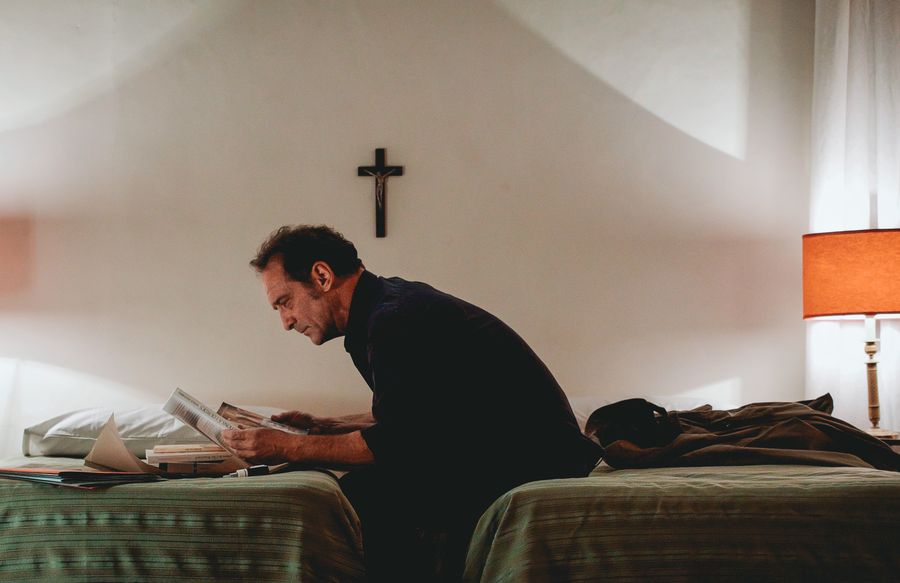Why closed doors never open when faith is reduced to an ‘enlightened choice’
On the afternoon of June 24, 1981, three young girls reported seeing the shape of a woman, whom they identified as the Virgin Mary, outside the village of Medjugorje in present-day Bosnia-Herzegovina. Some claim the apparitions still continue today, more than 35 years later.
Medjugorje has become a phenomenon of world proportions, and a big question mark for believers and nonbelievers alike. Are the apparitions true? How can we be sure? Where does the Church stand on it?
“The Apparition,” written and directed by Xavier Giannoli and set for limited release in theaters September 7, is a fictional take on a Medjugorje-like story.
Fifteen-year-old Anna claims to have seen the Virgin Mary in the little village of Carbarat in France. The details are strongly reminiscent of Medjugorje: a remote, rural setting, a female teenage visionary, a Franciscan parish priest at loggerheads with his bishop and the Church establishment, flocks of pilgrims and a boost in tourism triggered by the apparitions.

Jacques Mayano, a journalist and a nonbeliever, is recruited by the Congregation for the Doctrine of Faith to investigate the legitimacy of the apparent supernatural phenomena. The setup is promising: Both a layman and the Church are on a quest to discover the truth.
The movie should be praised for portraying both sides of the faith divide rather impartially: Mayano is not your cynical angry atheist, nor are the members of the Church commission the stereotypical corrupt philistines we’ve come to expect in this type of movie.
The premises, in short, seem perfect for answering some of the aforementioned questions.
Except that “The Apparition” provides no answers. Images of closed doors recur throughout the movie. Anna, the visionary, prays in solitude in front of a chapel whose doors have been walled up. In her room, the shape of a cross marks the empty spot where a crucifix once hung.
The movie ends with the protagonist, Mayano, abandoning a broken image of Mary in front of a monastery in the desert whose doors are blocked. The symbolism is even too clear: the quest ends in confusion, the mystery cannot be unlocked.
From the narrative point of view, it is a disastrous choice. A detective story that begins with a murder should end with the disclosure of the culprit. A film that begins with a question should end with an answer, especially if it’s going to take more than two hours of the viewer’s time.
The author’s philosophical position (i.e., “there are no answers”), should have been expressed through a different narrative form (a documentary?), or else, with a different plot line.
Much of the action in the central part of the movie revolves around a subplot concerning a friend of the protagonist, named Meriem, a young girl whose mother was murdered and who ended up escaping the foster home where she lived to work as a volunteer in Jordan.
This subplot comes full circle at the movie’s end, resulting in an important but rather artificial twist that does not alter the movie’s essentially agnostic position. In “The Apparition,” faith is “an enlightened choice,” which needs not, and cannot be based on proofs, for nothing that pertains to faith can be proven.
Another prominent theme in the film is loneliness. Anna, the young visionary, has no real friend left in this world (except for Meriem, with whom she exchanges letters) and spends long hours in solitude praying to a god who never answers.
Mayano’s pursuit begins and ends in the desert. In the director’s view, the search for truth about God is a “personal, secret quest.”
For Giannoli, the real answer is the journey itself. This is hardly an original idea.
The notion that the truth cannot really be achieved, that everything is endlessly debatable from a thousand points of view, and that all that ultimately matters is an individual’s subjective judgment may have seemed new and liberating to the generations growing up in the 1960s and ’70s.
But their children and grandchildren, as today’s culture clearly reflects, are tired of navigating this endless intellectual void. They are eager for clear, definitive answers, no matter how terrifying the truth is.
Interestingly, the motif of closed doors so copiously adopted in the movie is deliberately and insistently reversed in the Gospels.
What was hidden has been revealed, “the eternal life that was with the Father was made visible to us,” wrote St. John the Evangelist (1 John 1.2). The veil of the temple, which for the Jews symbolized the inaccessibility of God, was torn in two (Matthew 27.50–1). Revelation makes God accessible, his Incarnation made him one of us.
Although faith is a gift, it is based on the real, rational experience of the risen Christ, made visible in his Church. One might wish that we could soon see a movie that gives narrative force to the idea that the door has been opened, that there is someone beyond the veil. And that the quest for truth does not end in desperate loneliness.
Stefano Rebeggiani is an assistant professor of Classics at the University of Southern California. He lives in Los Angeles with his wife and two children.
SPECIAL OFFER! 44 issues of Angelus for just $25! For less than 50 cents a week, get the finest in Catholic journalism with first-rate analysis of the events and trends shaping the Church and the world, plus the practical advice from the world’s best spiritual writers on prayer and Catholic living, along with great features about Catholic life in Los Angeles. Subscribe now!

